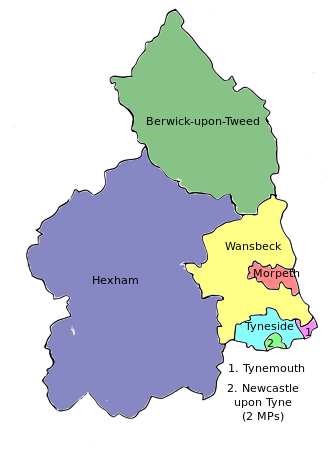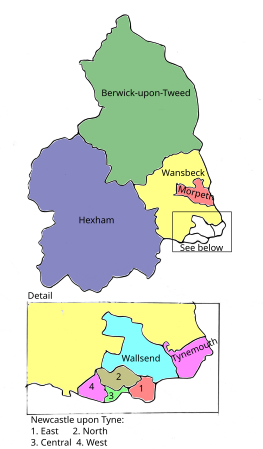The county of Northumberland has returned four MPs to the UK Parliament since 1983. Under the Local Government Act 1972, which came into effect on 1 April 1974, the boundaries of the historic/ administrative county were significantly altered with the south-east of the county, comprising more than half the electorate, being transferred to the new metropolitan county of Tyne and Wear. These changes were reflected in the following redistribution of parliamentary seats which did not come into effect until the 1983 general election, resulting in a reduction in the county's representation from 10 to 4 MPs.
Number of seats
The table below shows the number of MPs representing Northumberland at each major redistribution of seats affecting the county.
| Year | County
seats1 |
Borough
seats1 |
Total |
| Historic County | |||
| Prior to 1832 | 2 | 6 | 8 |
| 1832-1885 | 4 | 6 | 10 |
| 1885-1918 | 4 | 4 | 8 |
| 1918-1950 | 3 | 7 | 10 |
| 1950-1974 | 3 | 7 | 10 |
| Current County | |||
| 1974-19832 | 3 | 1 | 4 |
| 1983–present | 3 | 1 | 4 |
1Prior to 1950, seats were classified as County Divisions or Parliamentary Boroughs. Since 1950, they have been classified as County or Borough Constituencies.
2Approximate equivalent number of constituencies. Prior to the redistribution coming into effect for the 1983 general election, two constituencies were split between Northumberland and Tyne and Wear and two were wholly within the reconfigured county.
Constituencies timeline
County seat Borough seat
| Constituency | Prior to 1832 | 1832-1885 | 1885-1918 | 1918-1950 | 1950-1974 | 1974-1983 | 1983–present |
|---|---|---|---|---|---|---|---|
| Northumberland | 1290-1832 (2 MPs) | ||||||
| North Northumberland | 1832-1885 (2 MPs) | ||||||
| Berwick-upon-Tweed | 1512-1885 (2 MPs) | 1885–present | |||||
| Morpeth | 1553-1832 (2 MPs) | 1832-1950 | 1950-1983 | ||||
| South Northumberland | 1832-1885 (2 MPs) | ||||||
| Wansbeck | 1885-1950 | 1983–present | |||||
| Blyth | 1950-1983 | ||||||
| Blyth Valley | 1983–present | ||||||
| Hexham | 1885–present | ||||||
| Tynemouth and North Shields | 1832-1885 | Part of Tyne and Wear from 1974 | |||||
| Tynemouth | 1885---> | ||||||
| Tyneside | 1885-1918 | ||||||
| Wallsend | 1918---> | ||||||
| Newcastle upon Tyne | 1283-1918 (2 MPs) | ||||||
| Newcastle upon Tyne East | 1918---> | ||||||
| Newcastle upon Tyne North | 1918---> | ||||||
| Newcastle upon Tyne West | 1918---> | ||||||
| Newcastle upon Tyne Central | 1918---> | ||||||
Boundary reviews
Prior to 1832
Since 1290, the Parliamentary County of Northumberland, along with all other English counties regardless of size or population, had elected two MPs ( Knights of the Shire) to the House of Commons.
The county also included three Parliamentary Boroughs, namely Berwick-upon-Tweed, Morpeth and Newcastle upon Tyne, all returning two MPs (burgesses) each.
1832
The Great Reform Act of 1832 radically changed the representation of the House of Commons, with the County being divided into the Northern and Southern Divisions, [1] both returning two MPs. [2] The representation of Morpeth, which included the parish of Bedlington, was reduced to one MP. [3] [4] Tynemouth was established as a single-member Borough [5] - named Tynemouth and North Shields under the Parliamentary Boundaries Act 1832. [6] [7]
1868
Under the Boundary Act 1868, the boundaries of Morpeth were further extended to include the townships of Cowpen and Newsham (which incorporprated the town of Blyth). [8] [9] There were no other changes.
1885
Under the Redistribution of Seats Act 1885, the two two-member county divisions were replaced by four single-member constituencies, namely Berwick-upon-Tweed, Wansbeck, Hexham and Tyneside. [10] The Parliamentary Borough of Berwick-upon-Tweed was abolished. [11] Tynemouth and North Shields became known as Tynemouth, [12] with no changes to its boundaries.
1918
Under the Representation of the People Act 1918, the number of constituencies in Northumberland was increased back up to 10 as the two-member borough of Newcastle upon Tyne was replaced by four Divisions – Central, East, North and West. [13]
The County Division of Tyneside was abolished and its contents distributed as follows:
- the majority of the electorate, comprising the municipal borough of Wallsend and the urban districts of Gosforth, Longbenton and Weetslade formed the new Parliamentary Borough of Wallsend; [14]
- the former urban districts of Walker, and Benwell and Fenham which had been abolished in 1904 and absorbed into the County Borough of Newcastle upon Tyne were included in Newcastle upon Tyne East and West respectively; and
- the urban district of Newburn and surrounding rural areas were transferred to Wansbeck. [15]
Elsewhere, Berwick-upon-Tweed gained Amble from Wansbeck and Rothbury from Hexham, and Ashington was transferred from Wansbeck to Morpeth. [15]
1950
As a result of the redistribution enacted by the Representation of the People Act 1948, Northumberland's representation remained at 10 MPs. [16]
A new borough constituency named Blyth was established, which included the towns of Blyth and Bedlington, previously part of Morpeth. Wansbeck was abolished with its contents distributed as follows:
- rural areas around Morpeth, including Newbiggin-by-the-Sea, to Morpeth;
- Seaton Valley urban district (incorporating Cramlington, Seghill, Earsdon and Seaton Delaval) to Blyth;
- Whitley Bay to Tynemouth;
- rural areas to the west of Newcastle upon Tyne to Hexham; and
- Newburn to Newcastle upon Tyne West – necessitating the redrawing of the boundaries of the other three Newcastle upon Tyne seats.
1955
There was only one change resulting from the First Periodic Review of Westminster constituencies – the transfer of Benwell ward from Newcastle upon Tyne West to Newcastle upon Tyne Central. [17]
1974 (Feb)
There were no changes resulting from the Second Periodic Review, which came into effect for the February 1974 election. [18]
1974 (Apr)
Shortly after the Second Periodic Review came into effect, the county was subject to a major reconfiguration under the terms of the Local Government Act 1972. As a result, with effect from 1 April 1974, the four Newcastle upon Tyne constituencies and those of Wallsend and Tynemouth1, together with small areas of Hexham and Blyth, became part of the metropolitan county of Tyne and Wear.
1 Apart from the small community of Seaton Sluice.
1983
The next change to parliamentary constituency boundaries, following the recommendations of the Third Periodic Review, reflected the change in county boundaries and reorganisation of local government authorities in 1974. [19] This review did not come into effect for a further nine years, at the 1983 general election, and resulted in the following changes:
- Morpeth was abolished and, with the exception of northern rural areas which were transferred to Berwick-upon-Tweed, its contents formed the bulk of the re-established constituency of Wansbeck (which had very little in common with the original constituency);
- Blyth was renamed Blyth Valley, with Bedlington being included in Wansbeck; and
- the small areas of Blyth ( Earsdon and Backworth) and Hexham (part of Castle Ward rural district) which had been absorbed into the new county of Tyne and Wear were transferred to Wallsend and Newcastle upon Tyne North respectively.
1997
There were no changes under the Fourth Review. [20]
2010
At the Fifth Review there were only minor changes due to the revision of local authority ward boundaries. [21] [22]
Maps
-
1885-1918
-
1918-1950
-
1955-1983
-
2010-present
Communities timeline
The table below shows which constituencies represented major communities within the current county from 1885 onwards.
| Town | 1885-1918 | 1918-1950 | 1950-1983 | 1983-present |
|---|---|---|---|---|
| Alnwick | Berwick-upon-Tweed | |||
| Amble | Wansbeck | Berwick-upon-Tweed | ||
| Ashington | Wansbeck | Morpeth | Wansbeck | |
| Bedlington | Morpeth | Wansbeck | ||
| Berwick-upon-Tweed | Berwick-upon-Tweed | |||
| Blyth | Morpeth | Blyth | Blyth Valley | |
| Cramlington | Wansbeck | Blyth | Blyth Valley | |
| Hexham | Hexham | |||
| Morpeth | Morpeth | Wansbeck | ||
| Newbiggin-by-the-Sea | Wansbeck | Morpeth | Wansbeck | |
| Ponteland | Wansbeck | Hexham | ||
| Prudhoe | Hexham | |||
| Rothbury | Hexham | Berwick-upon-Tweed | ||
| Seaton Delaval | Wansbeck | Blyth | Blyth Valley | |
See also
- List of parliamentary constituencies in Northumberland
- History of parliamentary constituencies and boundaries in Tyne and Wear
References
- ^ Great Britain; Rickards, George K. (George Kettilby) (1807). The statutes of the United Kingdom of Great Britain and Ireland [1807-1868/69]. unknown library. London, His Majesty's statute and law printers. p. 335.
- ^ "HMSO Boundary Commission Report 1832 Northumberland".
- ^ "HMSO Boundary Commission Report 1832 Morpeth".
- ^ "Representation of the People Act 1832 S.II". vLex. Retrieved 2022-09-11.
- ^ "Representation of the People Act 1832 S.IV". vLex. Retrieved 2022-09-11.
- ^ Great Britain; Rickards, George K. (George Kettilby) (1807). The statutes of the United Kingdom of Great Britain and Ireland [1807-1868/69]. unknown library. London, His Majesty's statute and law printers. p. 353.
- ^ "HMSO Boundary Commission 1832 North Shields".
- ^ Great Britain (1807). The statutes of the United Kingdom of Great Britain and Ireland [1807-1868/69]. unknown library. London, His Majesty's statute and law printers. p. 138.
- ^ "HMSO Boundary Commission Report Morpeth".
- ^ Great Britain, Incorporated Council of Law Reporting for England and Wales. The public general acts. unknown library. Proprietors of the Law Journal Reports, 1884. p. 170.
- ^ Great Britain, Incorporated Council of Law Reporting for England and Wales. The public general acts. unknown library. Proprietors of the Law Journal Reports, 1884. p. 124.
-
^
"Leigh Rayment's historical list of MPs - Constituencies beginning with "T" (part 2)". Archived from the original on 9 October 2014. Retrieved 2022-09-12.
{{ cite web}}: CS1 maint: unfit URL ( link) - ^ Fraser, Hugh (1918). The Representation of the people act, 1918 : with explanatory notes. University of California Libraries. London : Sweet and Maxwell. pp. 447–448.
- ^ Fraser, Hugh (1918). The Representation of the people act, 1918 : with explanatory notes. University of California Libraries. London : Sweet and Maxwell. p. 460.
- ^ a b Fraser, Hugh (1918). The Representation of the people act, 1918 : with explanatory notes. University of California Libraries. London : Sweet and Maxwell. p. 517.
- ^ "Representation of the People Act 1948". pp. 110–111.
- ^ Craig, Fred W. S. (1972). Boundaries of parliamentary constituencies 1885-1972;. Chichester: Political Reference Publications. p. 82. ISBN 0-900178-09-4. OCLC 539011.
- ^ Craig, Fred W. S. (1972). Boundaries of parliamentary constituencies 1885-1972;. Chichester: Political Reference Publications. pp. 139–140. ISBN 0-900178-09-4. OCLC 539011.
- ^ "The Parliamentary Constituencies (England) Order 1983" (PDF). pp. 62–63.
- ^ "The Parliamentary Constituencies (England) Order 1995". County of Northumberland.
- ^ "The Parliamentary Constituencies (England) Order 2007". In Northumberland.
- ^ "Boundary Commission for England Fifth Periodical Report" (PDF). pp. 396–398.



